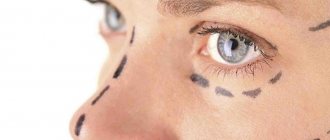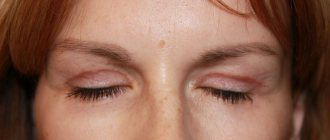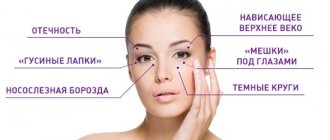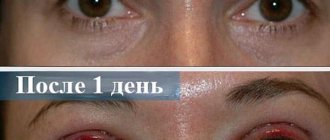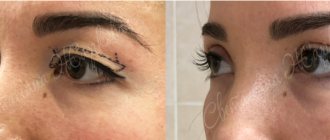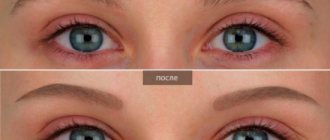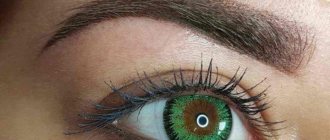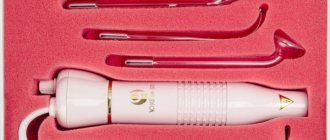Home » Blepharoplasty » Rehabilitation
Many women know that, first of all, age can be determined by the condition of the eyes and eyelids, because they are the ones who lose their youth and freshness before other facial areas. The solution to this problem was blepharoplasty, a surgical procedure that involves lifting the eyelids. In this article we will talk about how to care for your skin after this operation.
Anatomical features of the eyelids
The eyelid is designed in such a “grooved” manner that multiple folds of skin provide a tight closure without any tension or tension on the tissue. The outer layer of the eyelid is represented by the thinnest skin. The dermis of this thickness (less than 1 mm) is not present anywhere else in the body. Under the skin there is a circular muscle, which ensures the mobility of the eyelids. Then, deeper still, a thin membrane separates the muscle from the fatty tissue. Finally, the back layer of the eyelid - the conjunctiva - is in direct contact with the cornea. At the junction of the eyelid with the anterior surface of the eyeball there is a conjunctival sac. The rigidity of the eyelids is given by the cartilaginous plates that make up their frame base.
The eyelids are innervated by branches of the facial nerve, which are woven into the orbicularis oculi muscle along its outer and lower edges. The skin of the eyelids constantly experiences quite significant stress, so its aging begins already at the age of about 30 years. The dermis becomes less elastic, its excess appears, gathering in folds and sagging. Fat deposits and wrinkles appear around the eyes. Together with drooping forehead skin, stretched upper eyelids give the face a tired and heavy expression.
It has been noted that such age-related changes are accompanied by more or less pronounced impairment of peripheral vision and an increase in intraocular pressure. Blepharoplasty, which removes excess fat and skin from the eyelids, prevents the development of these conditions.
In the arsenal of modern plastic surgery, there are many technologies and techniques that are successfully used when performing blepharoplasty. Subjective complaints, study of anamnesis and heredity, objective diagnosis of the condition of the eyelids, analysis of the connection between aesthetic problems and disorders in the visual system - all this together allows an experienced specialist to develop a strictly individual plan for surgery and subsequent rehabilitation.
Medicines
The pain that appears after recovery from anesthesia is usually not severe. But if unpleasant sensations grow and interfere with life, it is better to eliminate them.
To do this you need to take the following medications:
- Paracetamol;
- Baralgin;
- Nise;
- MOMENT;
- Ketonal.
Decongestant therapy consists of taking potassium-sparing diuretics: Triampur, Veroshpiron, Hypothiazide. To prevent infection, you need to treat your eyelids with antiseptics - Furacilin or Chlorhexidine.
Furacilin
To eliminate colloidal scars, you need a step-by-step approach:
- First, a corticosteroid drug (Diprospan or Kenalog) is injected deep into the fibrous compaction, which makes the scar soft and accelerates resorption. Here it is wise to choose the exact dosage and depth of administration;
- Then, using a laser, the surface of the skin is leveled and the scar is painted over to match the color of the surrounding tissue. In this way, you can, if not remove the scar, then make it much invisible.
Types of blepharoplasty surgeries
Plastic surgery is possible on both the lower and upper eyelids. Accordingly, they talk about “lower” or “upper” blepharoplasty.
Upper blepharoplasty is usually aimed at eliminating drooping eyelids. The result of this operation is a wider opening of the palpebral fissure, rejuvenation and liveliness of the look.
Lower blepharoplasty may include removal of excess intraorbital fat or be aimed only at tightening the skin (fat-sparing blepharoplasty), eliminating eyelid hernias, ectropion, repositioning of lacrimal openings, etc.
Plastic surgery of the lower and upper eyelids can be performed percutaneously or through transconjunctival access.
Important elements of blepharoplasty are often canthopexy and canthoplasty - tightening the corners and changing the shape of the eyes. However, these procedures can also be performed as independent plastic surgery.
In some cases, blepharoplasty may include restoration of the lacrimal ducts. Such plastic surgery of the lacrimal punctum is usually performed for medical reasons in the presence of abnormalities in the development of the eye, or to eliminate the consequences of injury.
Among patients with an Asian type of appearance, eyelid surgery is quite common, making it possible to bring the eye shape closer to the European type. This type of blepharoplasty can be performed with or without incisions.
Drooping and drooping eyelids (ptosis) can also be corrected through surgical blepharoplasty.
Charging for rejuvenation and eyelid lifting
To strengthen your lower eyelid, use the Thoughtful Lady . The technique for doing it is as follows:
- To perform the exercise you will need your middle and index fingers. Place the middle pad to the inner corner of the eye, and the index one to the place where the eyebrow ends.
- Look straight ahead.
- Start squinting, while straining your lower eyelid as much as you can;
- Count to ten and relax your eyelid. Repeat 10 times.
- At the end of the exercise, raise your eyes up as if trying to look at something. Tighten the muscles of the lower eyelid as much as possible and hold for half a minute.
- This exercise must be repeated daily.
To tighten the outer corner of the eye, it is recommended to perform the Geisha .
- You need to close your eyes.
- Place your index fingers at the corners of your eyes and pull them upward, imitating the eyes of a “Chinese woman.”
- Raise your eyelids as high as possible;
- Hold for 5 seconds;
- Relax your eyes;
- Repeat the charge 7 times.
With age, the shape of the eyes tends to narrow, and each of us wants to be the owner of large, expressive eyes.
To prevent eye narrowing, face building experts recommend an effective exercise called “Day and Night” .
- Place your fingers at the inner and outer corners of your eyes, creating a "V" shape.
- Lightly press the pads of your fingers onto the above area;
- Look forward, straining your eyelid. Leave the upper part of the eyelid motionless.
- Close your eyes for 30 seconds;
- After performing these steps, relax your eyes;
- It is necessary to perform 10 manipulations in one approach.
- You need to repeat this exercise daily.
Indications for blepharoplasty
Aesthetic blepharoplasty is always caused by the patient’s subjective dissatisfaction with his appearance. Psychological discomfort may be associated with the congenital structure of the eyelids or be a consequence of age-related changes. The most common complaints include:
- dissatisfaction with the shape of the eyes;
- “bags” under the eyes (fatty hernias of the lower eyelids);
- excess skin on the upper eyelids;
- wrinkles in the corners and under the eyes.
Blepharoplasty for medical reasons is performed in the following cases:
- eversion or inversion of the eyelid;
- pathology of the lacrimal opening;
- eyelid ptosis;
- eyelid hernias, etc.
Local remedies
External remedies will help eliminate the unpleasant consequences of blepharoplasty. To combat hematomas at home, creams and ointments are most often used:
- Hydrocortisone;
- Traumeel S;
- Lyoton;
- Lokoid;
- Indovazin.
To make itching go away and wounds heal faster, use Blefarogel or Imoferase cream. To prevent fibrous tissue from growing and to get a soft and even scar, you need to use silicone-based ointments: Clearvin, Kelofibraza, Dermatix gel or Contractubex.
To relieve dryness, irritation and redness of the eyes, the following drops are used:
- Oksial;
- Katinorm;
- Innoxa;
- Artificial tear;
- Systane.
The solution should be applied to the inside of the lower eyelid, pulling it slightly to the side. Folk remedies are ideal for tissue regeneration, but they can only be used after the wound has completely healed.
To reduce swelling, you need to make a compress from raw potatoes, and rubbing with ice from sage or chamomile will not only restore attractiveness and youth to the look, but will also tighten the flabby skin under the eyes, smooth out wrinkles and folds.
YouTube responded with an error: The request cannot be completed because you have exceeded your quota.
Rate this article:
- Related Posts
- When can you wear makeup after blepharoplasty?
- When can you drink alcohol after blepharoplasty?
- What should you not do after blepharoplasty?
- What care is needed after upper eyelid blepharoplasty?
- Why do you need eye exercises after blepharoplasty?
- Who needs laser resurfacing after blepharoplasty?
Preparing for surgery
In order to predict the effectiveness of the planned operation, preparation for blepharoplasty always necessarily includes an assessment of the elasticity of the eyelid skin. In old age, this characteristic is almost always reduced. In such cases, blepharoplasty surgery should include canthopexy to prevent postoperative lower eyelid drooping.
Preparation for blepharoplasty, like any other surgical procedure, requires a comprehensive diagnosis and may include:
- collection of complaints and anamnestic data;
- laboratory tests of blood composition;
- ECG;
- examination by a therapist;
- consultation with specialized specialists (in the presence of comorbid chronic diseases);
- conversation with an anesthesiologist and choice of anesthesia method.
Our ophthalmology center is a highly specialized eye clinic, and therefore the extensive experience of doctors and the availability of the necessary equipment allow us to achieve high results in eyelid surgery for both therapeutic and aesthetic purposes.
Anti-wrinkle exercises
Due to the fact that the muscles around the eyes often experience tension, this area is rich in expression wrinkles.
To eliminate them, this set of exercises is effective:
- You need to slightly stretch the skin near the tips of the eyes, and with your eyes closed, make circular movements with your pupils. The exercise is repeated 5-6 times clockwise and counterclockwise;
- Pressing your fingers on the upper eyelid, lift your eyes up and close your eyes. Repeat this movement several times, taking breaks to relax;
- At the end, open and close your eyes 5-6 times, squeezing them.
Important! For a fruitful fight against facial wrinkles, the regularity of gymnastics plays an important role.
Blepharoplasty technique
The blepharoplasty operation can last, depending on the initial condition of the eyelids and the wishes of the patient, from 30 minutes to 2 hours. Local or general drugs, as well as their combinations, are used for pain relief.
The surgical plan and optimal methods in each case are purely individual. Careful preliminary diagnosis here is a particularly significant factor in the success of surgical care. The doctor not only tries to delve as deeply as possible into the content of the problems that led the patient to surgery, but also to evaluate the reconstructive possibilities, which, even with the modern development of surgery, are still not limitless, and they are often limited not so much by technology as by the resources of the body itself.
Modern techniques allow for correction without external incisions or sutures, guaranteeing aesthetic results of the highest level. Even if there is a need for excision, the integrity of the skin is disrupted in places of natural folds, which over time makes the traces of surgical intervention invisible.
At the end of the operation, a special aseptic bandage is applied to the eyelids, which can be removed after 4-6 hours. If the patient experiences pain after the end of anesthesia, it can be relieved with appropriate medications, but blepharoplasty, as a rule, does not cause significant discomfort during the rehabilitation period.
How to speed up rehabilitation?
On average, the rehabilitation period after blepharoplasty lasts 14-30 days and depends on the volume and type of surgery, as well as on the individual characteristics of the patient. Manual and physiotherapeutic procedures, taking medications and ointments will help speed up this process.
Never prescribe self-medication! This should be done by the doctor who performed the blepharoplasty. If you have questions or doubts, it is better to contact him or go for a consultation with a dermatologist.
We recommend: When can you wear makeup after blepharoplasty?
Compliance with the regime, a balanced diet and proper care of the skin of the eyelids significantly speeds up the period of full recovery and reduces the risk of complications.
Features of the postoperative period
Blepharoplasty is often performed “in one day”, i.e. the patient can leave the hospital in the evening after the operation. In case of a difficult recovery from anesthesia or if there are medical indications, the operated patient remains in the clinic for a day.
If stitches were applied during the operation, they are removed after 4-5 days. During the first week, subcutaneous hematomas may persist, which gradually resolve. Postoperative tissue swelling lasts up to two weeks; in order to reduce it, it is recommended to sleep on high pillows at night.
The eyes are regularly treated with medications that the surgeon will prescribe upon discharge. They relieve inflammation and prevent the formation of crusts on the skin.
In the eyelash growth area after surgery, a decrease in skin sensitivity may be observed, which is restored over time.
Resumption of normal lifestyle and professional activities is recommended no earlier than the 10th postoperative day. From this moment on, you can use decorative cosmetics, although application directly to the eyelids is contraindicated for another two weeks.
Outdoors, it is recommended to protect your eyes with tinted glasses. In addition, in the early postoperative period, it is advisable to stop using contact lenses.
You should avoid physical activity, sports and overwork for a month.
The final effectiveness of blepharoplasty is assessed no earlier than six months later. If necessary, minor re-correction is carried out. The effect of eyelid surgery lasts for 7-10 years or longer. This indicator largely depends on lifestyle, nutrition, and mental state. Postoperative scars are located out of sight.
How to care for your eyelids after blepharoplasty?
Proper eyelid care after blepharoplasty accelerates the disappearance of edema and bruises. With its help, you can achieve the best results of plastic surgery and maintain them for as long as possible – 10 years. How to care for your eyelids?
We recommend: How long does upper eyelid blepharoplasty take to heal?
The main rule after blepharoplasty is to avoid anything that puts stress on the eyes and eyelids. To eliminate swelling, you need to give up alcohol and smoking - in combination, these factors contribute to lymph stagnation and swelling of the eyelids. For this reason, you need to avoid salty foods - they retain water in the body, which leads to swelling. You need to sleep only on your back, and put a high pillow under your head.
You need to limit yourself in reading small print, working at the computer, watching TV for a long time, and wearing contact lenses. You should also avoid intense staring and bright light to avoid straining the eye muscles. Instead of contact lenses, you will have to wear glasses for 2-3 weeks. Also try not to tilt your head.
The second rule is to protect your eyes and eyelids from external influences. Do not go outside in windy weather; wear sunglasses. For this reason, avoid cosmetics and soaps. It is better to wash your face with chamomile decoction - it has an anti-inflammatory effect. Also avoid thermal radiation: saunas, baths.
Swelling after surgery will go away faster if you apply cold compresses to it. To prevent infection, you need to use antiseptics after surgery. But the main thing here is not to overdo it, so as not to cause skin irritation. After blepharoplasty, it is useful to do eye exercises, but in moderation so as not to overstrain your eyes.
Contraindications to blepharoplasty
Typical contraindications for eyelid surgery are the same as for other types of surgical treatment. Whether they are absolute or relative (i.e., surmountable or negligible) is determined during preoperative diagnosis. When making a decision, the ratio of possible risks and predicted benefits of the intervention is assessed mainly. Specific restrictions may be imposed, first of all, by diseases of the visual system (acute and chronic diseases of the conjunctiva, lacrimal glands and ducts, dry eye syndrome, blepharochalasis (excessive swelling around the eyes), blepharospasm, hyperthyroidism and a number of other ophthalmopathological conditions. In this case, advisory participation an ophthalmologist is strictly necessary.
How to process and what to smear
If the recovery process after surgery proceeds as usual, there is no need to use healing accelerating agents; the body will cope with everything on its own.
Experts advise treating the seams with Chlorhexidine or fresh chamomile decoction, performing light and stroking movements with a cotton swab, without putting pressure on the scars.
There is no need to coat the seams after blepharoplasty. And for the eyes, for preventive purposes, antiseptic drops are prescribed. The need to use other medications, if necessary, is determined only by a doctor.
If a patient has a tendency to form keloid scars, it is important to warn the surgeon about this so that he can select medications that prevent the formation of excess connective tissue.
